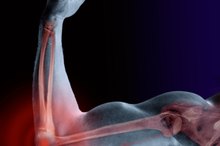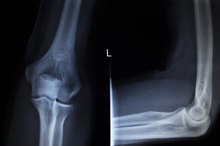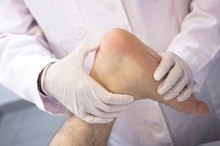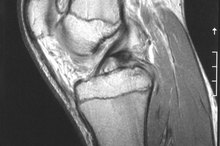Signs & Symptoms of Shoulder Injuries
The shoulder is a ball-and-socket joint 1. The ball is called the head of the humerus, or upper-arm bone, and the socket is called the glenoid, which is part of the shoulder bone. The shoulder is the most movable joint in the human body. It is also the most common site for different types of injuries. such as torn rotator cuffs, dislocations, sprains and fractures. Knowing what signs and symptoms to look for can help you identify a shoulder problem and then take the needed steps to help resolve it before it worsens.
If you are experiencing serious medical symptoms, seek emergency treatment immediately.
Noise
If you hear popping or grinding noises coming from your shoulder when you move it, this can be a symptom of injury. Grinding and popping noises can be caused by bone grinding against bone, fluid sacs of the glenohumeral joint bursting or tendons slipping over the bone. These sounds are mostly related to rotator cuff injuries.
Displaced Bone
Signs of a Bone Spur in Elbow
Learn More
A displaced bone can be a symptom of a shoulder injury. Your shoulder has three bones: the humerus, the bone of the upper arm; the clavicle, or collarbone, and the scapula, or shoulder blade. If one of these bones becomes displaced, it can make your shoulder appear deformed. When the humerus is dislocated from the joint, the shoulder will appear to slouch backward or forward. When the clavicle is displaced, it can create a bump on the top of the shoulder.
- A displaced bone can be a symptom of a shoulder injury.
- When the humerus is dislocated from the joint, the shoulder will appear to slouch backward or forward.
Pain
The most common symptom of shoulder injury is pain. The location of the pain will differ depending on the kind of injury. For example, tendinitis will usually cause pain throughout the length of the upper arm or on the front of your shoulder, while a torn rotator cuff will usually cause pain on the top of your shoulder.
Stiffness
Torn Tendons & Ligaments From Hyperextension
Learn More
Shoulder stiffness, or frozen shoulder, is another symptom of shoulder injury. Stiffness indicates a diminished range of motion, such as difficulty raising the arm overhead or not being able reach behind your back even when assisted. Causes of shoulder stiffness include shoulder arthritis, endocrine disorders, surgery and trauma.
Related Articles
References
- “MRI of the Shoulder”; Michael B. Zlatkin; 2002
- “Orthopedic Physical Assessment”; David J. Magee; 2007
- NIH Publication No. 14-4865, Questions and Answers about Shoulder Problems. April 2014. (edited)
Writer Bio
Frank Dioso is a trained medical technologist working for prominent research institutions such as Quest Diagnostics and California Clinical Trials. He has, for many years, ghostwritten clinical trial reports for confidential pharmaceutical drugs and is currently contributing his clinical laboratory science knowledge to online how-to articles.









